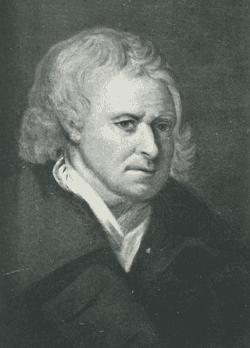John Henry Campbell, Landscape Painter
(b. 1757, d. 1828)
Landscape Painter
From A Dictionary of Irish Artists 1913

John Henry Campbell. Picture by William Cuming, P.R.H.A.; in possession of Mr. R. J. Nairn, 13 Westland Row, Dublin.
Was born in 1757, His father, a native of Herefordshire, married a Miss Beaufort, also of Herefordshire, and settled in Dublin where he became a partner with Graisbery, the King's Printer. John Henry, after completing his studies in the Dublin Society's School, established himself as a landscape painter in Dublin. In 1800, being then resident in Paradise Row, he sent a drawing, "Moonlight," to the exhibition held at Allen's, 32 Dame Street. Next year he was at 13 Trinity Street, and exhibited two landscape drawings in the Parliament House. He contributed four landscapes in 1802, and two in 1804, was a regular exhibitor from 1809 to 1819, and contributed to the Royal Hibernian Academy at its opening exhibition in 1826, and again in 1828. He painted both in oil and water-colour.
Amongst his water-colours are a "View of Dublin, Howth, etc., from Huband Bridge," exhibited in 1809 and now in the National Museum, Kildare Street; a "View near Rostrevor" in the National Gallery of Ireland; and a "Bridge over the Dodder, Upper Rathmines," in the possession of Mr. J. C. Nairn, 13 Westland Row. In the British Museum are two drawings by him: "The Little Sugar-Loaf," dated 1806, and "Rathgar Castle," dated 1807. A "View of Dunleary Pier and part of the Town," drawn by him in 1789, was etched by J. Wright, who published it at 34 Mary's Abbey. In Ferrar's "View of Ancient and Modern Dublin," 1796, is an engraving of "Sarah Bridge" by Clayton, after a drawing by Campbell. A large aquatint by A. Courcell, of "Powerscourt Waterfall," with a pic-nic party, was done from a drawing by him. Two landscapes in oil: "View on Lough Erne, with Devenish Island and Round Tower," and "Fassaroe Bridge"— the latter painted in 1821—belong to Mr. J. C. Nairn. A "View of Killarney, with Torc Mountain," and a "Banditti with Prisoners," the landscape after Both, the figures by G. Nairn (q.v.), belong to the Rev. F. Sadleir, 9 Gardiner's Place.
Campbell's works are pleasing and well painted, and as an artist he ranks high among contemporary Irish painters in water-colour. He died on 10th May, 1828. He had two sons, John, who resided in Belfast, where he was employed as a designer of patterns for damask and linen, and Charles, an officer in the army, killed at the storming of Badajos; and a daughter Cecilia Margaret, a painter both in oil and water-colour, who married George Nairn, A.R.H.A. (q.v.).
« Cecilia Margaret Campbell | Contents and Search | John Edward Carew »
